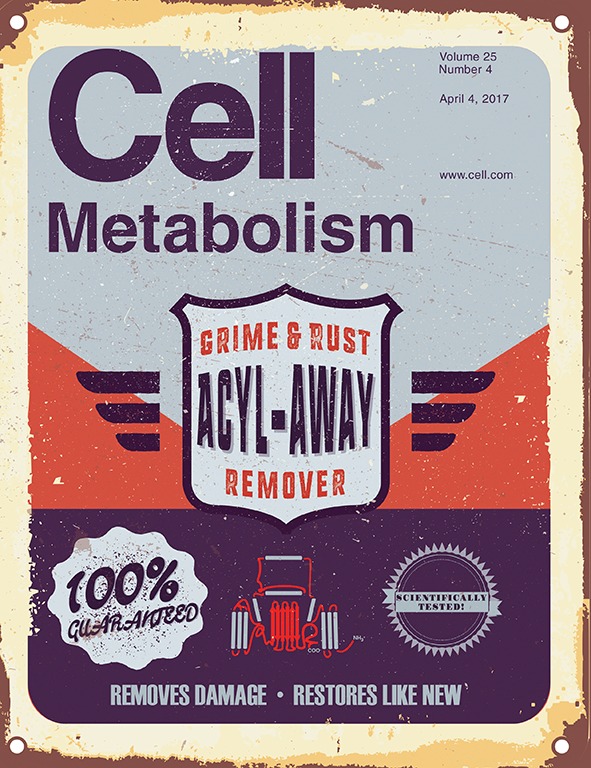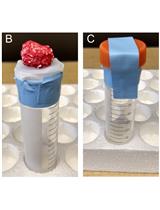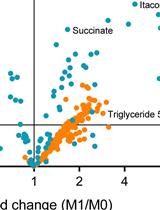- EN - English
- CN - 中文
Extraction and Analysis of Pan-metabolome Polar Metabolites by Ultra Performance Liquid Chromatography–Tandem Mass Spectrometry (UPLC-MS/MS)
超高效液相色谱 - 串联质谱法(UPLC-MS/MS)提取和分析泛代谢组极性代谢产物
发布: 2018年02月05日第8卷第3期 DOI: 10.21769/BioProtoc.2715 浏览次数: 9907
评审: Neelanjan BoseAnca Flavia SavulescuAnonymous reviewer(s)
Abstract
Modern triple quadrupole mass spectrometers provide the ability to detect and quantify a large number of metabolites using tandem mass spectrometry (MS/MS). Liquid chromatography (LC) is advantageous, as it does not require derivatization procedures and a large diversity in physiochemical characteristics of analytes can be accommodated through a variety of column chemistries. Recently, the comprehensive optimization of LC-MS metabolomics using design of experiments (COLMeD) approach has been described and used by our group to develop robust LC-MS workflows (Rhoades and Weljie, 2016). The optimized LC-MS/MS method described here has been utilized extensively for metabolomics analysis of polar metabolites. Typically, tissue or biofluid samples are extracted using a modified Bligh-Dyer protocol (Bligh and Dyer, 1959; Tambellini et al., 2013). The protocol described herein describes this workflow using targeted polar metabolite multiple reaction monitoring (MRM) from tissues and biofluids via ultra-performance liquid chromatography-tandem mass spectrometry (UPLC-MS/MS). This workflow has been utilized extensively for chronometabolic analysis (Krishnaiah et al., 2017), with applications generalized to other types of analyses as well (Sengupta et al., 2017; Sivanand et al., 2017).
Keywords: UPLC-MS (UPLC-MS)Background
Metabolomics is a field of study aiming to comprehensively analyze metabolites through the use of various analytical detection methods, namely mass spectrometry (MS) and nuclear magnetic resonance (NMR) (Liu and Locasale, 2017). Although both NMR and MS are essential tools in metabolomics, mass spectrometry can analyze samples with greater sensitivity (Liu and Locasale, 2017). Within mass spectrometry, various approaches are available, however a rapid approach to profile the global metabolome is needed (Lv et al., 2011; Rhoades and Weljie, 2016). Advancements in triple quadrupole mass spectrometers have made them well suited for ion-switching methods (scanning in both positive and negative ion modes within a single analysis) in addition to enabling reproducible and sensitive targeted profiling of numerous metabolites (Lv et al., 2011; Gika et al., 2012; Yuan et al., 2012; Rhoades and Weljie, 2016). Additionally, LC typically does not require extensive sample preparation, nor derivatization, which allows for the detection of a broader range of metabolites (Gika et al., 2012; Liu and Locasale, 2017). Nonetheless, development of LC-MS methods to comprehensively analyze small polar metabolites is nontrivial, and requires advanced modeling to optimize both LC and MS factors simultaneously. Thus, the COLMeD approach aimed to address this challenge and enabled a more comprehensive metabolite analysis across platforms including on a triple quadrupole mass spectrometer (Rhoades and Weljie, 2016). The LC-MS workflow on a triple quadrupole is described here and has been used to successfully study metabolomics in a circadian context in which 179 metabolites were successfully profiled and analyzed (Krishnaiah et al., 2017).
Materials and Reagents
- Pipette tips 1,000 μl, 200 μl, 10 μl (Gilson, catalog numbers: F1735001 , F1733001 , F1732001 )
- 1.7 ml PosiClick tubes (Denville Scientific, catalog number: C2170 )
- 2.0 ml Safe-Lock tubes (Eppendorf, catalog number: 022363352 )
- Mass spectrometry vials and caps–Verex Vial Kit, 9 mm, PP, 300 μl + PTFE/Silicone, pre slit (Phenomenex, catalog number: AR0-9992-13 )
- Stainless steel beads 5 mm (QIAGEN, catalog number: 69989 )
- Gloves (Denville Scientific, catalog number: G4161 )
- Sample trays
- VanGuard cartridge holder (WATERS, catalog number: 186007949 )
- XBridge BEH Amide 2.5 μm XP Vanguard Cartridge, 2.1 x 5 mm (WATERS, catalog number: 186007763 )
- XBridge BEH Amide 2.5 μm, 2.1 x 100 mm column XP (WATERS, catalog number: 186006091 )
- Acquity UPLC column In-Line Filter Kit (WATERS, catalog number: 205000343 )
- MilliQ water–18 mΩ, 0.22 μm filter (Merck, catalog number: MPGP04001 )
- Acetonitrile–Optima LC/MS (Fisher Scientific, catalog number: A955-4 )
- Ammonium acetate (Sigma-Aldrich, catalog number: 73594-25G-F )
- Ammonium hydroxide TraceMetal grade (Fisher Scientific, catalog number: A512-P500 )
- Argon compressed gas (Airgas)
- Chloroform (Fisher Scientific, catalog number: C298-1 )
- Methanol optima LCMS (Fisher Scientific, catalog number: A456-4 )
- Nitrogen gas (Airgas, catalog number: NI230LT230RB )
- Solvent A (see Recipes)
- Solvent B (see Recipes)
- Seal wash (see Recipes)
Equipment
- Pipettes (P1000, P200, P20, P10)
- Centrifuge (Eppendorf, model: 5430 R , catalog number: 022620511)
- Vortex
- ACQUITY H-Class UPLC (WATERS, model: ACQUITY UPLC H-Class )
- Bath Sonicator (VWR, catalog number: 97043-976 )
- Speed Vacuum–Vacufuge Plus (Eppendorf, model: Vacufuge plus , catalog number: 022822993)
- TissueLyser II (QIAGEN, catalog number: 85300 )
- Xevo TQ-S Micro (WATERS, model: Xevo TQ-S Micro )
Software
- MassLynx Version 4.1
- TargetLynx XS
- R (version 3.3)
Procedure
文章信息
版权信息
© 2018 The Authors; exclusive licensee Bio-protocol LLC.
如何引用
Malik, D. M., Rhoades, S. D. and Weljie, A. M. (2018). Extraction and Analysis of Pan-metabolome Polar Metabolites by Ultra Performance Liquid Chromatography–Tandem Mass Spectrometry (UPLC-MS/MS). Bio-protocol 8(3): e2715. DOI: 10.21769/BioProtoc.2715.
分类
系统生物学 > 代谢组学 > 生物流体 > 极性代谢产物
系统生物学 > 代谢组学 > 组织
您对这篇实验方法有问题吗?
在此处发布您的问题,我们将邀请本文作者来回答。同时,我们会将您的问题发布到Bio-protocol Exchange,以便寻求社区成员的帮助。
Share
Bluesky
X
Copy link













![基于气相色谱-[Orbitrap] 质谱的人血样本代谢物分析的自动化顺序衍生化方法](https://en-cdn.bio-protocol.org/imageup/arcimg/20250107224024942.jpg?t=1766132841)